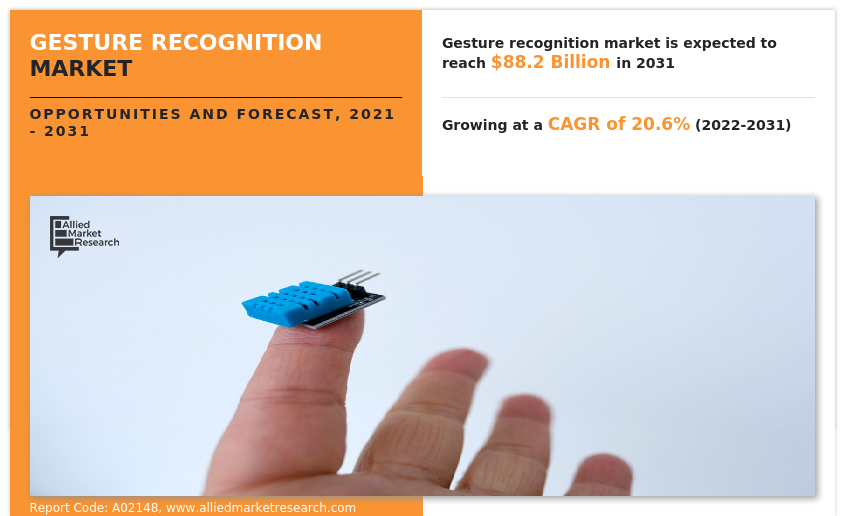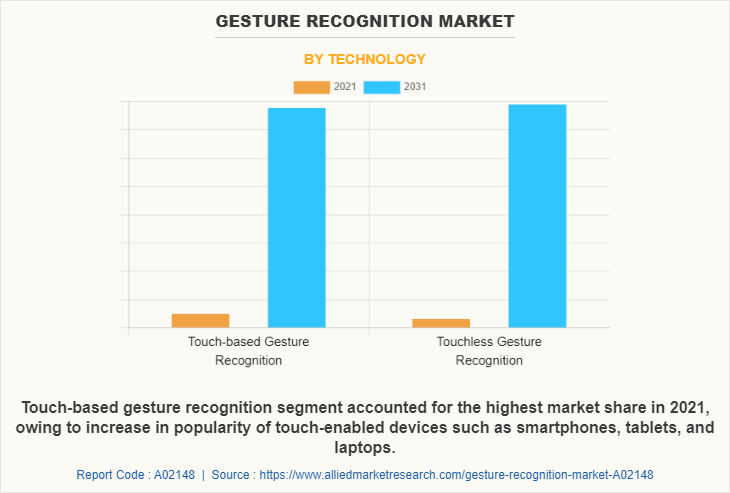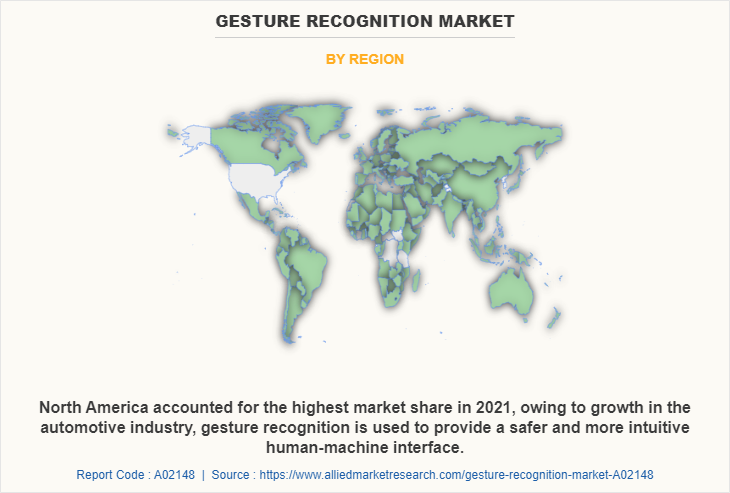Gesture Recognition Market Insights, 2031
The global gesture recognition market was valued at USD 13.9 billion in 2021, and is projected to reach USD 88.2 billion by 2031, growing at a CAGR of 20.6% from 2022 to 2031.
Increasing demand for contactless interfaces and rising popularity of gaming applications are driving the growth of the market. In addition, increasing usage of smart devices in various industries is driving the growth of the gesture recognition market. However, high development and implementation costs and high battery power consumption by gesture recognition components limit the growth of the market. Conversely, the growing demand for augmented and virtual reality applications is anticipated to provide numerous opportunities for the expansion of the market during the forecast period.

Gesture recognition is a subfield of computer vision and machine learning that involves capturing, analyzing, and interpreting various types of human gestures. Gestures can be any physical movement of the body, such as hand movements, facial expressions, or body postures. Gesture recognition technology typically involves using sensors, cameras, or other devices to capture data about the movements of the user. This data is then processed by machine learning algorithms or other software to identify the gesture and interpret its meaning.
The report focuses on growth prospects, restraints, and analysis of the global gesture recognition market trends. The study provides Porter’s five forces analysis to understand the impact of various factors, such as bargaining power of suppliers, competitive intensity of competitors, threat of new entrants, threat of substitutes, and bargaining power of buyers on the global gesture recognition market share.
Segment Review
The global gesture recognition market is segmented into technology, industry vertical, and region. By technology, it is classified into touch-based gesture recognition and touchless gesture recognition. Based on industry vertical, it is bifurcated into consumer electronics, gaming, healthcare, automotive, aerospace & defense, and others. Region-wise, it is analyzed across North America, Europe, Asia-Pacific, and LAMEA.

On the basis of technology, the touch-based system segment dominated the gesture recognition market share in 2021 and is expected to continue its dominance during the forecast period, owing to the increase in popularity of touch-enabled devices such as smartphones, tablets, and laptops. However, the touchless-based system segment is expected to witness the highest growth in the upcoming years, owing to a growing demand for touchless interfaces in various industries, such as healthcare, retail, and hospitality.

Region wise, the gesture recognition market was dominated by North America in 2021 and is expected to maintain its position during the forecast period, owing to increase in adoption and growth of advanced and latest technologies, such as augmented and virtual reality in various industry verticals. However, Asia-Pacific is expected to witness significant growth during the forecast period, due to the rapid expansion of the consumer electronics market in countries such as China, Japan, South Korea, and India has created a demand for more intuitive and user-friendly interfaces of gesture recognition solutions, thereby driving the market growth across the region.
The global gesture recognition market is dominated by key players such as Amazon Web Services, Inc., Apple Inc., Google LLC, Hitachi Ltd., IBM Corporation, Microsoft Corporation, Qualcomm Technologies, Inc., Orbbec, Intel Corporation, GestureTek Technologies, LTU Technologies, Cipia (Eyesight Technologies Ltd.), Infineon Technologies AG, Microchip Technology Incorporated. These players have adopted various strategies to increase their gesture recognition market penetration and strengthen their position in the gesture recognition industry.
Top Impacting Factors
Increase in demand for contactless interfaces
Contactless interfaces find a wide range of applications across industries, including healthcare, retail, automotive, and BFSI, owing to increase in demand for contactless interfaces which is one of the major drivers for the growth of the gesture recognition market. In addition, one of the trending applications across industry verticals is rise in proliferation and acceptance of contactless payment systems. This mode of payment is also becoming popular especially among consumers and merchants, with many countries and retailers accepting contactless payments as a standard payment method. For instance, according to estimates from Barclays bank, in 2022, contactless users made almost 220 touch-based transactions. These factors are further likely to drive the growth of contactless interfaces in the gesture recognition market.
The COVID-19 pandemic has led to an increase in the need for contactless interfaces, which remains even after the pandemic situation. Furthermore, contactless interfaces are a common choice for public places and high-traffic locations as they reduce the likelihood of transferring infectious diseases. On the contrary, rise in technological advancements to support the way of life of individuals has transformed paradigms in public places, such as hospitality industries. The hospitality sector and its associated businesses are constantly working to implement a tech-enabled solution that helps in improving customer satisfaction.
For instance, in September 2020, SS&C launched TimeShareWare Arrive, an innovative contactless guest communications system for visitors. This feature enables shared-ownership properties to streamline resort operations and enable social distancing techniques to provide visitors and employees satisfaction. Moreover, contactless interfaces are a key feature of gesture recognition technology and provide a range of benefits, including convenience, hygiene, accessibility, and a more engaging user experience. Thus, these factors are expected to contribute to the growth of the gesture recognition market.
Rise in popularity of gaming applications
Gesture recognition technology has become an integral part of gaming applications, providing users with an immersive and interactive experience. Thus, growing digitalization globally is leading to the rise in the popularity of gaming applications which in turn, is anticipated to grow the gesture recognition market during the forecast period. Gaming has become a popular form of entertainment and social activity, with more people spending time online and on mobile devices, which further increases the interest of developers to utilize gesture recognition technology. In addition, the increase in popularity of eSports and competitive gaming has given individuals new possibilities to express creative talents and interact with other players worldwide.
For instance, in January 2023, data.ai published a new report which depicted that consumers utilized nearly five hours a day on mobile devices, which is almost one-third of the total day. Therefore, the gaming industry experienced significant growth in recent years. Also, several gaming businesses are developing creative games that make use of new technologies including gesture recognition, virtual reality, and artificial intelligence and machine learning. For instance, in July 2022, Hackster.io organized a project that undertakes the development of a simple game that uses gesture recognition to control player movement. It can also offer immersive gaming without the need for electronics by using AI as a control mechanism for the game environment. Such developments further create more business opportunities for gaming applications in the gesture recognition market.
Digital Capabilities:
Gesture recognition refers to the ability of a system to recognize and interpret human gestures, such as hand movements, body language, and facial expressions, through the use of digital technologies. With the increasing sophistication of digital technologies, gesture recognition has become an increasingly important capability in a wide range of applications, including gaming, robotics, virtual reality, and human-computer interaction. Here are some of the digital capabilities of gesture recognition:
- Hand and body tracking: Gesture recognition systems can track the movement of the hands and body in real-time, allowing for precise and accurate tracking of gestures and movements.
- Facial recognition: Some gesture recognition systems can also recognize facial expressions and movements, allowing for more natural and intuitive interactions between humans and computers.
- Multi-user recognition: Many gesture recognition systems are capable of recognizing and tracking multiple users at the same time, allowing for collaborative and interactive experiences.
- Depth sensing: Some gesture recognition systems use depth-sensing technologies such as structured light or time-of-flight sensors to capture 3D data about the user's movements, allowing for more accurate and precise tracking.
- Machine learning: Gesture recognition systems can be trained using machine learning algorithms to recognize specific gestures or movements, allowing for greater customization and flexibility in their use.
- Integration with other technologies: Gesture recognition can be integrated with other digital technologies, such as virtual reality or augmented reality, to create immersive and interactive experiences.
Overall, gesture recognition is a powerful digital capability that has the potential to revolutionize the way we interact with technology, enabling more natural and intuitive interactions that can enhance productivity, creativity, and entertainment.
End-User Adoption:
End-user adoption of gesture recognition has been steadily increasing over the years, as more and more people become familiar with the technology and its capabilities. Gesture recognition technology has been integrated into a wide range of devices, such as smartphones, gaming consoles, and home automation systems, which has helped to drive adoption among end users. Improved user experience, increased accessibility, and advancements in technology are some of the key factors that have contributed to the adoption of gesture recognition technology by end users. Gesture recognition technology can provide a more natural and intuitive way of interacting with digital devices, which can improve the overall user experience.
In addition, it provides a more accessible way of interacting with digital devices for people with disabilities or mobility impairments. Furthermore, the development of new and more sophisticated sensors, cameras, and algorithms has improved the accuracy and reliability of gesture recognition technology, making it more appealing to end users.
Despite these factors, there are still some challenges to the widespread adoption of gesture recognition technology among end users. These include concerns around privacy and security, the need for standardized interfaces, and the potential for user fatigue or frustration with gesture-based interactions. However, as the technology continues to evolve and improve, it is likely that these challenges will be addressed, and gesture recognition will become an even more popular and widely adopted technology among end users.
Government Initiatives:
Governments across the globe have shown interest in gesture recognition technology and its potential applications. Some governments have launched initiatives to support the development and implementation of gesture recognition technology in various sectors. Some governments have launched initiatives to support the development and implementation of gesture recognition technology in healthcare settings. For example, the US National Institutes of Health (NIH) has funded research on the use of gesture recognition technology to improve the diagnosis and treatment of neurological disorders. Gesture recognition technology can also be used in education to create more interactive and engaging learning experiences.
Some governments have launched initiatives to support the development and implementation of gesture recognition technology in educational settings. For example, the Singapore government has launched a project to develop a gesture recognition system for use in classrooms. Such factors are expected to have a positive impact on gesture recognition market growth during the forecast period.
Furthermore, gesture recognition technology can be used in transportation to improve safety and efficiency. Some governments have launched initiatives to support the development and implementation of gesture recognition technology in transportation settings. For example, the European Union has funded research on the use of gesture recognition technology to improve driver safety. Overall, gesture recognition technology has the potential to benefit many different sectors, and governments are starting to recognize its potential applications. Government initiatives can help to accelerate the development and implementation of gesture recognition technology in various sectors, leading to improved outcomes for individuals and society as a whole.
Key Benefits for Stakeholders
- The study provides an in-depth analysis of the global gesture recognition market forecast along with current & future trends to explain the imminent investment pockets.
- Information about key drivers, restraints, & opportunities and their impact analysis on global gesture recognition trends is provided in the report.
- Porter’s five forces analysis illustrates the potency of the buyers and suppliers operating in the industry.
- The quantitative analysis of the gesture recognition market from 2022 to 2031 is provided to determine the market potential.
Gesture Recognition Market Report Highlights
| Aspects | Details |
| Market Size By 2031 | USD 88.2 billion |
| Growth Rate | CAGR of 20.6% |
| Forecast period | 2021 - 2031 |
| Report Pages | 255 |
| By Technology |
|
| By Industry Vertical |
|
| By Region |
|
| Key Market Players | LTU technologies, Infineon Technologies AG, Qualcomm Technologies, Inc. , IBM Corporation, Google LLC (Alphabet), GestureTek Technologies, Microchip Technology Incorporated, Hitachi Ltd., Cipia Vision Ltd. (Formerly known as Eye Sight Technologies Ltd.), Orbbec, Microsoft Corporation, Apple Inc., Intel Corporation, Amazon.com, Inc. |
Analyst Review
As per the perspective of CXOs of leading companies, the gesture recognition market is expected to grow at a promising rate during the forecast period. This is attributed to the growing utilization of AI and ML algorithms to interpret human gestures, along with increasing digitalization across industries, such as automotive, consumer electronics, and healthcare. Furthermore, strong efforts have been carried out to improve intelligent and natural interfaces between users and computer-based systems based on human gestures. It also provides an instinctive interface to both computers and humans. Hence, such gesture-based interfaces not only substitute the common interface devices but also exploits them to extend their functionality. Moreover, gesture recognition technology is the turning point in the development of VR/AR technology across the world. It can enable seamless non-touchable control of computerized devices to generate a highly interactive, yet fully immersive and flexible hybrid reality. Therefore, gesture recognition technology is gaining significant prominence and momentum among the wide end-user base, hence, contributing to the growth of the global market.
Key providers of the gesture recognition market are Amazon.com, Inc., Apple Inc., Google LLC, Microsoft Corporation, and LTU technologies. With the growth in demand for gesture recognition technology, various companies have acquired other companies to increase their business presence and product offerings. For instance, in November 2021, Qualcomm Technologies, Inc. acquired Clay Air, a client of Corum, an Edu-Tech company. This acquisition will strengthen Qualcomm’s XR technology stack with the addition of Clay Air’s highly accurate and power-efficient hardware agnostic technology. In addition, this acquisition will help Qualcomm in producing more effective and efficient gesture recognition products.
With the surge in demand for gesture recognition technology, a range of companies have expanded their current services to continue with the rising demand for gesture recognition technology in the market. For instance, in December 2022, Amazon upgraded their original product Echo Show by introducing a gesture feature in the product, which is now possible for a range of users to raise their hands to interact with the Echo Show device. Similarly, in October 2019, Google launched a product Pixel 4 that contains a small motion-sensing radar named Soli, which enable users to skip songs, snooze alarm and silence phone calls through hand gestures. This strategic acquisition and product launch initiative by key players is predicted to boost the demand for the gesture recognition market in the upcoming years.
The global gesture recognition market was valued at USD 13.9 billion in 2021, and is projected to reach USD 88.2 billion by 2031
The gesture recognition market is projected to grow at a compound annual growth rate of 20.6% from 2022 to 2031.
The key players profiled in the report include Amazon Web Services, Inc., Apple Inc., Google LLC, Hitachi Ltd., IBM Corporation, Microsoft Corporation, Qualcomm Technologies, Inc., Orbbec, Intel Corporation, GestureTek Technologies, LTU Technologies, Cipia (Eyesight Technologies Ltd.), Infineon Technologies AG, and Microchip Technology Incorporated.
Region wise, the gesture recognition market was dominated by North America
Increasing demand for contactless interfaces, the rising popularity of gaming applications, and the increasing usage of smart devices in various industries contribute toward the growth of the market.
Loading Table Of Content...
Loading Research Methodology...



